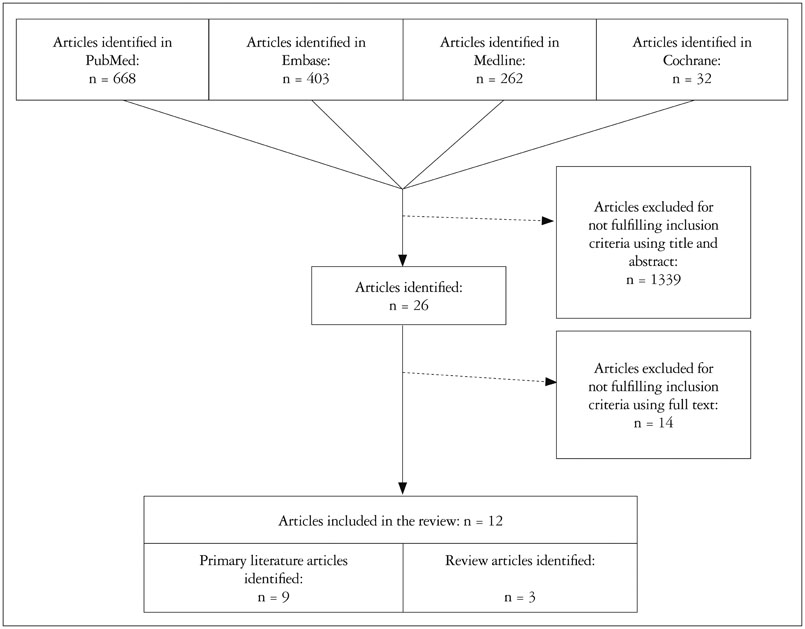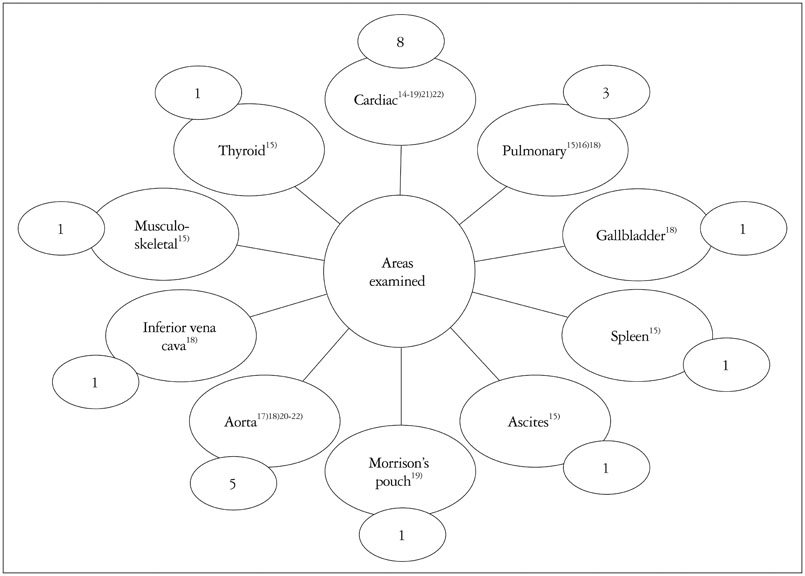J Cardiovasc Ultrasound.
2017 Sep;25(3):75-83. 10.4250/jcu.2017.25.3.75.
Hand-held Ultrasound Scanners in Medical Education: A Systematic Review
- Affiliations
-
- 1Swansea University Medical School, Singleton Park, Swansea, UK. victorgalusko@hotmail.co.uk
- 2Morriston Cardiac Regional Centre, ABMU LHB, Swansea, UK.
- 3Guy's and St Thomas' NHS Trust, London, UK.
- KMID: 2392252
- DOI: http://doi.org/10.4250/jcu.2017.25.3.75
Abstract
- BACKGROUND
Ultrasound imaging devices are becoming popular in clinical and teaching settings, but there is no systematic information on their use in medical education. We conducted a systematic review of hand-held ultrasound (HHU) devices in undergraduate medical education to delineate their role, significance, and limitations.
METHODS
We searched Cochrane, PubMed, Embase, and Medline using the strategy: [(Hand-held OR Portable OR Pocket OR "Point of Care Systems") AND Ultrasound] AND (Education OR Training OR Undergraduate OR "Medical Students" OR "Medical School"). We retained 12 articles focusing on undergraduate medical education. We summarised the patterns of HHU use, pooled and estimated sensitivity, and specificity of HHU for detection of left ventricular dysfunction.
RESULTS
Features reported were heterogeneous: training time (1-25 hours), number of students involved (1-an entire cohort), number of subjects scanned (27-211), and type of learning (self-directed vs. traditional lectures + hands-on sessions). Most studies reported cardiac HHU examinations, but other anatomical areas were examined, e.g. abdomen and thyroid. Pooled sensitivity 0.88 [95% confidence interval (CI) 0.83-0.92] and specificity 0.86 (95% CI 0.81-0.90) were high for the detection of left ventricular systolic dysfunction by students.
CONCLUSION
Data on HHU devices in medical education are scarce and incomplete, but following training students can achieve high diagnostic accuracy, albeit in a limited number of (mainly cardiac) pathologies. There is no consensus on protocols best-suited to the educational needs of medical students, nor data on long-term impact, decay in proficiency or on the financial implications of deploying HHU in this setting.
Keyword
MeSH Terms
Figure
Reference
-
1. Lapostolle F, Petrovic T, Lenoir G, Catineau J, Galinski M, Metzger J, Chanzy E, Adnet F. Usefulness of hand-held ultrasound devices in out-of-hospital diagnosis performed by emergency physicians. Am J Emerg Med. 2006; 24:237–242.2. Wright J, Noriega O, Ho H. The application of hand-held ultrasound scanner in teaching of telemedicine and rural medicine. Donald Sch J Ultrasound in Obstet Gynecol. 2014; 8:87–91.3. Kobal SL, Trento L, Baharami S, Tolstrup K, Naqvi TZ, Cercek B, Neuman Y, Mirocha J, Kar S, Forrester JS, Siegel RJ. Comparison of effectiveness of hand-carried ultrasound to bedside cardiovascular physical examination. Am J Cardiol. 2005; 96:1002–1006.4. Kimura BJ, Shaw DJ, Agan DL, Amundson SA, Ping AC, DeMaria AN. Value of a cardiovascular limited ultrasound examination using a hand-carried ultrasound device on clinical management in an outpatient medical clinic. Am J Cardiol. 2007; 100:321–325.5. Egan M, Ionescu A. The pocket echocardiograph: a useful new tool? Eur J Echocardiogr. 2008; 9:721–725.6. Greaves K, Jeetley P, Hickman M, Dwivedi G, Sabharwal N, Lim T, Janardhanan R, Senior R. The use of hand-carried ultrasound in the hospital setting--a cost-effective analysis. J Am Soc Echocardiogr. 2005; 18:620–625.7. Otto CM. Heartbeat: Echo anytime, anywhere by anyone? Heart. 2016; 102:1–2.8. Estai M, Bunt S. Best teaching practices in anatomy education: a critical review. Ann Anat. 2016; 208:151–157.9. Baltarowich OH, Di Salvo DN, Scoutt LM, Brown DL, Cox CW, DiPietro MA, Glazer DI, Hamper UM, Manning MA, Nazarian LN, Neutze JA, Romero M, Stephenson JW, Dubinsky TJ. National ultrasound curriculum for medical students. Ultrasound Q. 2014; 30:13–19.10. Sweetman GM, Crawford G, Hird K, Fear MW. The benefits and limitations of using ultrasonography to supplement anatomical understanding. Anat Sci Educ. 2013; 6:141–148.11. Tshibwabwa ET, Groves HM. Integration of ultrasound in the education programme in anatomy. Med Educ. 2005; 39:1148.12. Hammoudi N, Arangalage D, Boubrit L, Renaud MC, Isnard R, Collet JP, Cohen A, Duguet A. Ultrasound-based teaching of cardiac anatomy and physiology to undergraduate medical students. Arch Cardiovasc Dis. 2013; 106:487–491.13. Sicari R, Galderisi M, Voigt JU, Habib G, Zamorano JL, Lancellotti P, Badano LP. The use of pocket-size imaging devices: a position statement of the European Association of Echocardiography. Eur J Echocardiogr. 2011; 12:85–87.14. Cawthorn TR, Nickel C, O’Reilly M, Kafka H, Tam JW, Jackson LC, Sanfilippo AJ, Johri AM. Development and evaluation of methodologies for teaching focused cardiac ultrasound skills to medical students. J Am Soc Echocardiogr. 2014; 27:302–309.15. Fox JC, Schlang JR, Maldonado G, Lotfipour S, Clayman RV. Proactive medicine: the “UCI 30,” an ultrasound-based clinical initiative from the University of California, Irvine. Acad Med. 2014; 89:984–989.16. Mai TV, Ahn DT, Phillips CT, Agan DL, Kimura BJ. Feasibility of remote real-time guidance of a cardiac examination performed by novices using a pocket-sized ultrasound device. Emerg Med Int. 2013; 2013:627230.17. Stokke TM, Ruddox V, Sarvari SI, Otterstad JE, Aune E, Edvardsen T. Brief group training of medical students in focused cardiac ultrasound may improve diagnostic accuracy of physical examination. J Am Soc Echocardiogr. 2014; 27:1238–1246.18. Andersen GN, Viset A, Mjølstad OC, Salvesen O, Dalen H, Haugen BO. Feasibility and accuracy of point-of-care pocket-size ultrasonography performed by medical students. BMC Med Educ. 2014; 14:156.19. Gogalniceanu P, Sheena Y, Kashef E, Purkayastha S, Darzi A, Paraskeva P. Is basic emergency ultrasound training feasible as part of standard undergraduate medical education? J Surg Educ. 2010; 67:152–156.20. Bonnafy T, Lacroix P, Desormais I, Labrunie A, Marin B, Leclerc A, Oueslati A, Rollé F, Vignon P, Aboyans V. Reliability of the measurement of the abdominal aortic diameter by novice operators using a pocket-sized ultrasound system. Arch Cardiovasc Dis. 2013; 106:644–650.21. Filipiak-Strzecka D, John B, Kasprzak JD, Michalski B, Lipiec P. Pocket-size echocardiograph--a valuable tool for nonexperts or just a portable device for echocardiographers? Adv Med Sci. 2013; 58:67–72.22. Panoulas VF, Daigeler AL, Malaweera AS, Lota AS, Baskaran D, Rahman S, Nihoyannopoulos P. Pocket-size hand-held cardiac ultrasound as an adjunct to clinical examination in the hands of medical students and junior doctors. Eur Heart J Cardiovasc Imaging. 2013; 14:323–330.23. Lewiss RE, Hoffmann B, Beaulieu Y, Phelan MB. Point-of-care ultrasound education: the increasing role of simulation and multimedia resources. J Ultrasound Med. 2014; 33:27–32.24. Solomon SD, Saldana F. Point-of-care ultrasound in medical education--stop listening and look. N Engl J Med. 2014; 370:1083–1085.25. Seraphim A, Paschou SA, Grapsa J, Nihoyannopoulos P. Pocket-sized echocardiography devices: one stop shop service? J Cardiovasc Ultrasound. 2016; 24:1–6.26. Hothi SS, Sprigings D, Chambers J. Point-of-care cardiac ultrasound in acute medicine--the quick scan. Clin Med (Lond). 2014; 14:608–611.27. Barrett PM, Topol EJ. To truly look inside. Lancet. 2016; 387:1268–1269.28. Mehta M, Jacobson T, Peters D, Le E, Chadderdon S, Allen AJ, Caughey AB, Kaul S. Handheld ultrasound versus physical examination in patients referred for transthoracic echocardiography for a suspected cardiac condition. JACC Cardiovasc Imaging. 2014; 7:983–990.29. Chambers JB, Rajani R, Short N, Victor K, O’Kane K. Point-of-care cardiac ultrasound in acute internal medicine: how can it be delivered? Clin Med (Lond). 2015; 15:403–404.30. Webb EM, Cotton JB, Kane K, Straus CM, Topp KS, Naeger DM. Teaching point of care ultrasound skills in medical school: keeping radiology in the driver’s seat. Acad Radiol. 2014; 21:893–901.31. Johri A, Nadeau-Routhier C, Jaidka A, Church M. Handheld cardiac ultrasound: case series. 2014. 12. 11. cited 2016 Jul 26. Available from: https://itunes.apple.com/gb/book/handheld-cardiac-ultrasound/id950815260?mt=13.32. Kimura BJ, Sliman SM, Waalen J, Amundson SA, Shaw DJ. Retention of ultrasound skills and training in “point-of-care” cardiac ultrasound. J Am Soc Echocardiogr. 2016; 29:992–997.
- Full Text Links
- Actions
-
Cited
- CITED
-
- Close
- Share
- Similar articles
-
- Automated Breast Ultrasound: The Present and Future
- The Utility of Hand Held Autorefractometer for Refraction in Children
- Prediction of Outcomes from Cataract Patients by Using Hand Held Laser Interfrometry
- Ultrasonographic Diagnosis of the Hand and Wrist Joint
- Prediction of Visual Acuity in Macular Disease Using Hand-held Laser Interferometer



